Editors Note: As a fun experiment, we asked Bryan what the best song would be to listen to while you look at the images. He suggested this one:My Shepherd Will Supply My Needs by John Fahey on GroovesharkBryan Schutmaat’s newly-released photographic series, Grays the Mountain Sends, is quite stellar. The images depict desolate regions and isolated communities of the western United States with a deft touch and a sympathetic eye. His landscapes become emotional statements, and his portraits force you to wonder about the lives of the sitters. Looking through the images and their chosen sequence, you begin to feel like a narrative story is being told, one who’s specific arc you may never really know. Serious stuff, dudes. I was blown away by the work and decided to have a chat with the man in the mountains.
Advertisement
VICE: How long has this new project been in the making? Seems like you covered a lot of ground.
Bryan Schutmaat: Yeah, the photos were taken all over the Rockies. I shot everything over the course of a year and a half, but of the actual time spent on the road and in the towns with my camera was pretty scant.How long would you say you were on the road, actually shooting?
Man, that's tough to estimate. The trips were intermittent and varied in length. I think the longest one was a little over three weeks. That was my most ambitious road trip.Were you based in Brooklyn back then?
No, I was in Bozeman, Montana and Houston, Texas mostly. Living in Bozeman for the time that I did certainly put me closer to the subject matter though.Yeah, that would make things much easier than living on the East Coast. What was your process like? In terms of day to day stuff, you'd just drive and shoot things that came up?
Pretty much. I drove a lot, wandered around, went into bars, tried to meet people, and so on. Cafes too. I drank a lot of shitty coffee over the course of this work.
Bryan Schutmaat: Yeah, the photos were taken all over the Rockies. I shot everything over the course of a year and a half, but of the actual time spent on the road and in the towns with my camera was pretty scant.How long would you say you were on the road, actually shooting?
Man, that's tough to estimate. The trips were intermittent and varied in length. I think the longest one was a little over three weeks. That was my most ambitious road trip.Were you based in Brooklyn back then?
No, I was in Bozeman, Montana and Houston, Texas mostly. Living in Bozeman for the time that I did certainly put me closer to the subject matter though.Yeah, that would make things much easier than living on the East Coast. What was your process like? In terms of day to day stuff, you'd just drive and shoot things that came up?
Pretty much. I drove a lot, wandered around, went into bars, tried to meet people, and so on. Cafes too. I drank a lot of shitty coffee over the course of this work.

As a photographer, do you feel drawn to the road? Do you have an urge to take trips in the same way people like Robert Frank or Stephen Shore did?
Absolutely, I was just talking to a friend of mine last night about traveling and how it helps photography. When you're on the road wandering in unfamiliar places, it's like the senses become hyper-aware. Plus, there's the sense of space and freedom that can be comforting. All of those cliches.
Absolutely, I was just talking to a friend of mine last night about traveling and how it helps photography. When you're on the road wandering in unfamiliar places, it's like the senses become hyper-aware. Plus, there's the sense of space and freedom that can be comforting. All of those cliches.
Advertisement
You seem to be in the Alec Soth vein of road bound photographers, where you not only observe your surroundings and photograph landscapes, but you meet people and learn about them as well. How do you meet people? Just by being talkative and friendly?
Yeah, for sure. I would go into little mining towns and hang out. After some time, you're bound to run into somebody whose likeness would make a good portrait. I talked to those people about local industry, what food was good in town, politics, the weather, whatever. Though there were times when I'd just approach people about portraits right away, if the light was right, or if the social setting wasn't conducive to shooting the shit.And they were receptive?
Some of them, yes. I think other photographers who take pictures of strangers have better luck than I do, because I would say half of people I asked to photograph turned me down. But it was made up for by a number of the people I encountered who were unbelievably kind, who sat in front of my camera and showed me patience and generosity and good will. I wanted to talk about the poet, Richard Hugo. I have read that his work, especially the poem “Degrees of Gray in Philipsburg” really influenced this body of work for you. After reading, that poem, I found it added a whole new layer of illumination when I looked at the photos again. How much did his work directly influence this series?
It influenced the project pretty substantially, and in the photos I make some direct references to the poem. I thought of the ghost of Richard Hugo as my copilot. With that said, I think there are many vast differences between the poem and the photos. The poem was my jumping off platform. It got me out into the world making those photos, but along the way I learned that what I wanted to express wasn't the same as what Hugo wanted to express. I didn't want to adapt the poem like it was some kind of movie script, so I brought my own voice into it.
Yeah, for sure. I would go into little mining towns and hang out. After some time, you're bound to run into somebody whose likeness would make a good portrait. I talked to those people about local industry, what food was good in town, politics, the weather, whatever. Though there were times when I'd just approach people about portraits right away, if the light was right, or if the social setting wasn't conducive to shooting the shit.And they were receptive?
Some of them, yes. I think other photographers who take pictures of strangers have better luck than I do, because I would say half of people I asked to photograph turned me down. But it was made up for by a number of the people I encountered who were unbelievably kind, who sat in front of my camera and showed me patience and generosity and good will. I wanted to talk about the poet, Richard Hugo. I have read that his work, especially the poem “Degrees of Gray in Philipsburg” really influenced this body of work for you. After reading, that poem, I found it added a whole new layer of illumination when I looked at the photos again. How much did his work directly influence this series?
It influenced the project pretty substantially, and in the photos I make some direct references to the poem. I thought of the ghost of Richard Hugo as my copilot. With that said, I think there are many vast differences between the poem and the photos. The poem was my jumping off platform. It got me out into the world making those photos, but along the way I learned that what I wanted to express wasn't the same as what Hugo wanted to express. I didn't want to adapt the poem like it was some kind of movie script, so I brought my own voice into it.
Advertisement

I loved hearing him talk about the ram's head in the plastic bubble and then seeing your photograph of it.
Actually, it was a goat in the poem [laughing]. The ram was on the opposite side of the bar. Same bar though.It makes me happy that they’re still there, and that the bar is still there. The poem did add a sense of almost hopelessness to the already sad-looking people. Did you intend that? I also notice that almost all of the photos are taken in what looks to me like cold weather, adding another element of solitude.
I didn't intend to make anyone look hopeless. Even Degrees of Gray in Philipsburg isn't devoid of hope. Still there's this sense of dejection in the photos that's recognizable and, to some extent, in tune with the mood of the poem. I guess I was just singing a sad song with photos. And yes, many were taken in colder temperatures, not crazy cold, but cold enough for a Texan like me. This wasn't intentional—dealing with the weather is part of life out West.Hopeless is a strong word, but there's a sense of sadness I got for sure.
Yeah, no doubt.So you just graduated with your MFA. What's next up for you?
I'm thinking a lot about my next art project but I haven't started it yet. For now, I'm working in New York, but I imagine I'll move back to Texas at some point, closer to the regions of the country where I like to shoot.That's awesome. Live the dream, man.
Thanks. I'm trying.
Actually, it was a goat in the poem [laughing]. The ram was on the opposite side of the bar. Same bar though.It makes me happy that they’re still there, and that the bar is still there. The poem did add a sense of almost hopelessness to the already sad-looking people. Did you intend that? I also notice that almost all of the photos are taken in what looks to me like cold weather, adding another element of solitude.
I didn't intend to make anyone look hopeless. Even Degrees of Gray in Philipsburg isn't devoid of hope. Still there's this sense of dejection in the photos that's recognizable and, to some extent, in tune with the mood of the poem. I guess I was just singing a sad song with photos. And yes, many were taken in colder temperatures, not crazy cold, but cold enough for a Texan like me. This wasn't intentional—dealing with the weather is part of life out West.Hopeless is a strong word, but there's a sense of sadness I got for sure.
Yeah, no doubt.So you just graduated with your MFA. What's next up for you?
I'm thinking a lot about my next art project but I haven't started it yet. For now, I'm working in New York, but I imagine I'll move back to Texas at some point, closer to the regions of the country where I like to shoot.That's awesome. Live the dream, man.
Thanks. I'm trying.
Advertisement
You can see more of Bryan's work here.
